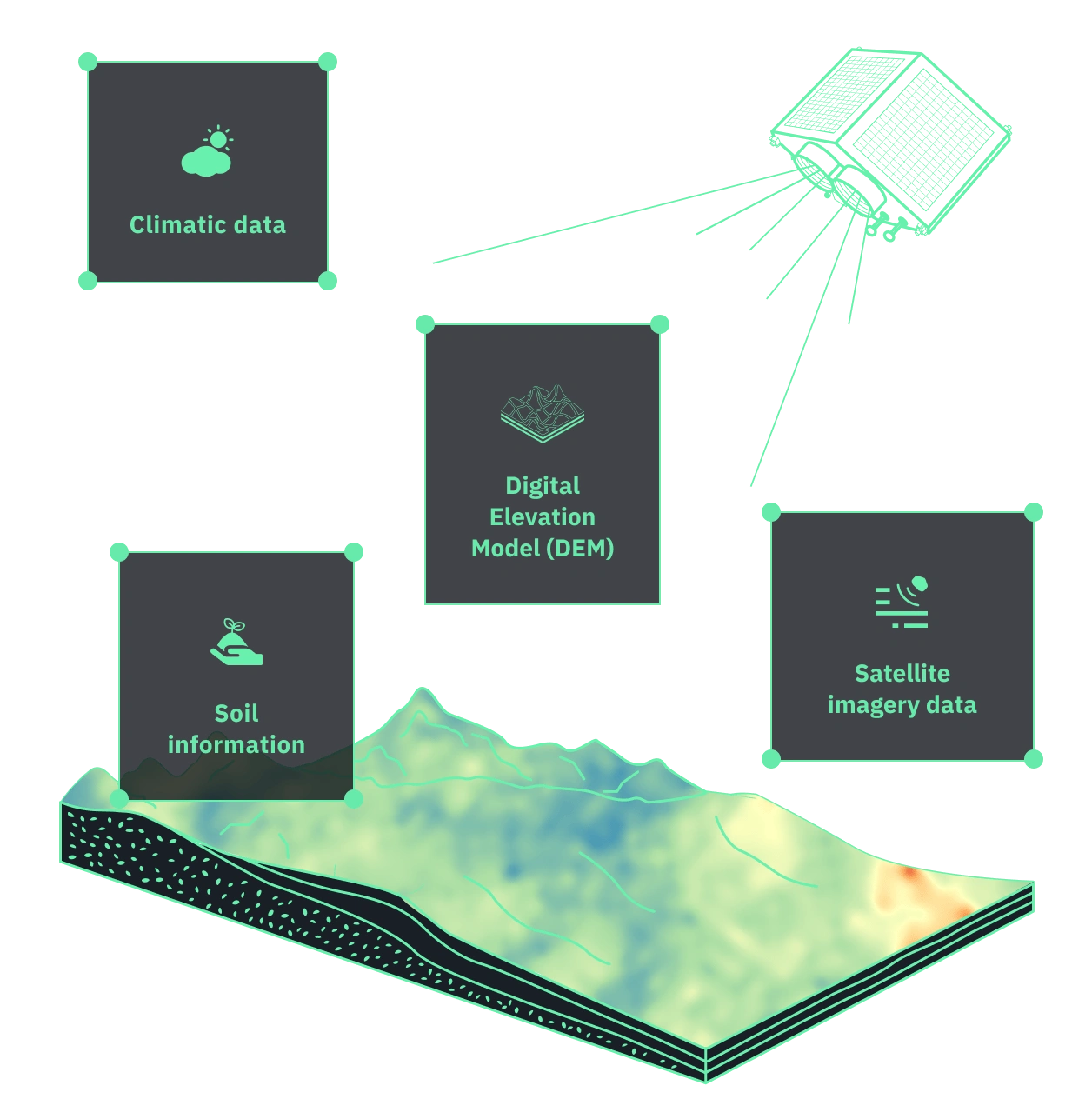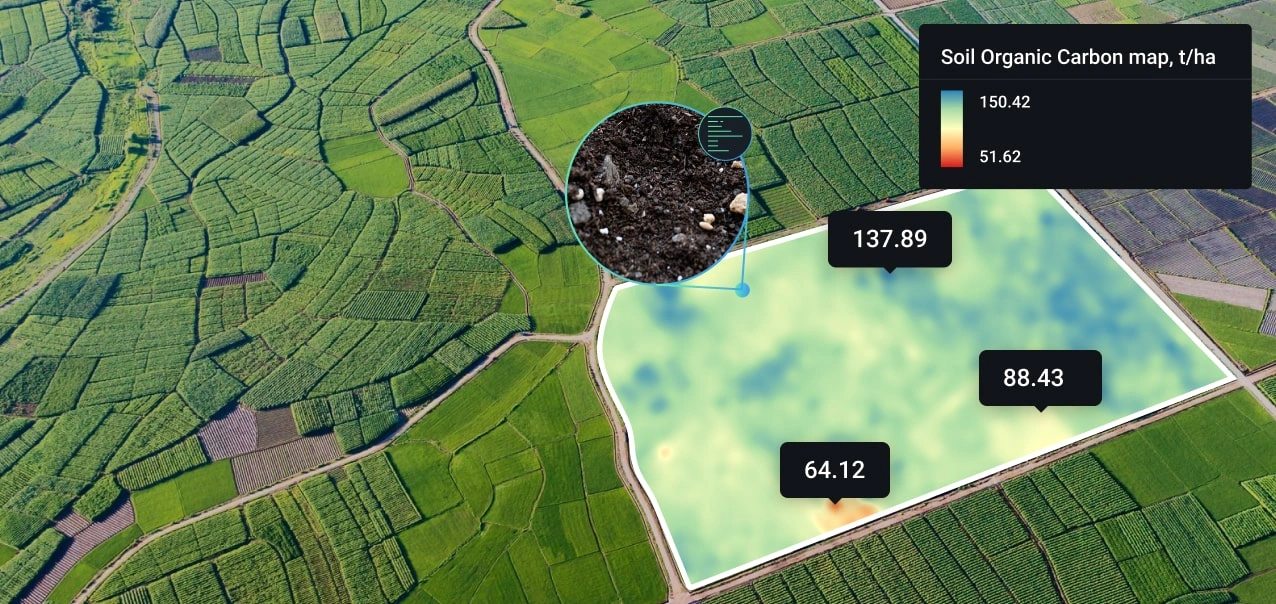Soil Organic Carbon Modeling: Experience the Difference with Our Method
Our approach combines soil organic carbon (SOC) models with remote sensing to help carbon project developers, government entities, and verification bodies efficiently measure, estimate, and predict soil organic carbon. This method leverages the power of 140 predictors and allows for significantly reducing the number of expensive physical soil samples needed for verification. The extensive range of predictors, including satellite imagery, greatly improves the accuracy of SOC estimations. Join us in exploring how our model is contributing to the realm of measuring soil carbon while aiding in the pursuit of a sustainable future.

What makes us stand out
Reliability
We already have a success story of winning a multi-million dollar contract for building a soil organic carbon model for the Australian government with our partner AgriProve. [Read here]
Satellite imagery
Our experienced team of RnD scientists uses machine learning to analyze both ground-based and satellite data to ensure high accuracy of our carbon management model.
Unique data
EOS SAT-1 — satellite created specifically for our needs — enables us to increase our carbon modeling and prediction accuracy by acquiring data across 11 bands and providing 1.4 m panchromatic and 2.8m multispectral high-resolution imagery.
Minimized expenses
We have enhanced the already existing world-renowned RothC model used by the Food and Agriculture Organization (FAO) to increase our prediction accuracy and help you save up to 90% on soil sampling.
Compliance
Our model's calculations comply with the Clean Energy Regulator and are adjustable for Verra, Gold Standard, and Climate Action Reserve, among others. Our scientists have completed regional training at FAO and received certificates in regional training for modeling and mapping soil organic carbon (SOC).
EOSDA SOC Advantages Over RothC Model
EOSDA, in developing its products and solutions, has always followed the formula of “let’s do business in a sustainable way”. We’ve already transformed the agriculture market around the globe with profitable and sustainable solutions addressing the most pressing issues. Finally, we realized we have the expertise and experience enough to step up the game and try our hand at carbon sequestration technologies – to tackle climate change head-on.
Our Science Team decided upon the renowned RothC model widely approved, among others, by the Food and Agriculture Organization of the United Nations (FAO), the Greenhouse Gas Inventory Office of Japan, and the Emissions Reduction Fund of Australia.
The trick was how to customize it to the needs of specific regions and overcome its limitations regarding the imagery resolutions and scaling possibilities. Undaunted by the challenge, our experts produced a more accurate, tailored and user-friendly model ready to assist EOSDA clients with their carbon offset projects. And now it’s action time.

- While RothC modeling typically relies on random forest or regression models for initial soil organic carbon mapping, EOSDA broadens the scope by offering the application of up to 15 distinct models. This enables us to accurately match the most suitable model to specific climatic-geographical zones, enhancing SOC assessment accuracy.
- EOSDA's advanced pipeline permits flexible carbon predictions for any duration within a 20-year period, providing more adaptable forecasting capabilities.
- EOSDA improves the processes of predictors selection and distribution according to their complexity.
- The EOSDA model integrates higher spatial resolution data, elevating the precision of the RothC predictive model.
- EOSDA uses an improved RothC model with up to 140 predictors across various categories, including climatic data, optical and SAR satellites data, DEM and its derived parameters data, and soil information.
- As EOSDA infrastructure is built on cloud technologies (AWS), EOSDA SOC model offers higher scaling possibilities, particularly beneficial for large projects.
- EOSDA's model reduces the number of soil samples needed for results verification by up to 90%.
- EOSDA's team comprises highly experienced soil science and soil carbon modeling experts, including ones with PhD degrees and over 30 years of experience, ensuring a strong scientific foundation for the model.
You can use our SOC model to:

- Save on soil sampling and increase profits from carbon credit generation.
- Use it as baseline for the carbon credit generation and creating a more positive footprint while increasing profit.
- Create accurate soil maps that illustrate its nutrient content, pH, etc.
- Optimize resource allocation (people, money, inputs, time) by upgrading farming activities to carbon sequestration MRV practices.
How it works
Predicting the increase in soil organic carbon on farmlands allows us to estimate the potential financial gains from adopting sustainable practices and earning agricultural carbon credits. Here’s how we do it:
-
Data collection
The client provides us with soil samples data, including key details about soil composition and organic carbon content. If the client is unable to supply certain pieces of data, we can fill in the gaps thanks to our extensive resources, research capabilities, and customized algorithms designed to meet the unique requirements of each carbon credit project.
-
Data Analysis
We use advanced algorithms to analyze the collected data and provide accurate measurements of your soil carbon storage. Depending on the complexity of a project, we use different number of predictors (up to 140) to increase accuracy by adapting our algorithms to territory, climatic parameters, culture, etc.
-
Credit Conversion
We prepare a baseline report that details the current amount of soil organic carbon in your field, as well as the SOC that was sequestrated during the project. The information provided in this report is necessary when applying for carbon credits, as it helps to convert your carbon stocks into carbon emission credits. We make sure the report strictly follows the client’s specific requirements and format.
-
Carbon amount forecasting
We utilize the RothC model to estimate the amount of soil organic carbon that will be sequestered in a field over several years. Additionally, we can also predict the potential carbon emissions from farming in case unsustainable practices are applied. This forecasting aids in determining the amount of carbon credits that could be earned by landowners. Additionally, it provides valuable insights for governments, NGOs, and other stakeholders interested in assessing SOC's contribution to addressing climate change, risks, and related issues.
Case study: EOSDA and AgriProve’ SOC modeling for Australian government
Challenge:
AgriProve, an Australian company, focuses on soil carbon projects with the following key activities:
- Collaborating with farmers to capture atmospheric carbon and store it in soil, thus enhancing soil quality and value
- Assisting in the increase of soil carbon levels to improve farm profitability
- Generating carbon credits and reducing environmental impacts
AgriProve significantly contributes to the Emissions Reduction Fund (ERF), being responsible for 80% of soil carbon projects and aiding in the acquisition of Australian carbon credit units for greenhouse gas reduction or carbon sequestration.
However, before adopting satellite soil monitoring via EOSDA Crop Monitoring, the company encountered several challenges:
- Reliance on various data providers for data collection and ERF product registration reporting
- Inefficient and time-consuming manual processes
- High error rates in the manual reporting process
Solution:
EOSDA has introduced a satellite-based precision agriculture solution for AgriProve, leveraging AWS Lambda by Amazon Web Services for serverless data gathering and analysis in soil carbon farming projects. This technology eliminates the need for server management, streamlining the process for AgriProve.
Thanks to EOSDA Crop Monitoring, AgriProve customers now can:
- Access historical farmland data
- Generate baseline reports with specific indices
- Monitor farmland progress throughout a project
Data is efficiently managed using Amazon S3, guaranteeing reliable and scalable storage and retrieval.
Outcomes:
AgriProve utilizes EOSDA Crop Monitoring platform for:
- Efficient management and monitoring of ~160,000 hectares of agricultural land.
- Streamlining soil carbon project initiation, reducing setup time from months to weeks.
AgriProve utilizes EOSDA Crop Monitoring platform for:
- Creation of baseline condition reports.
- Tracking of land management changes, improving cropping, pasture, and horticulture.
AgriProve also plans to incorporate additional data, such as moisture levels, to enhance analysis and assist farmers and landowners in optimizing management strategies.